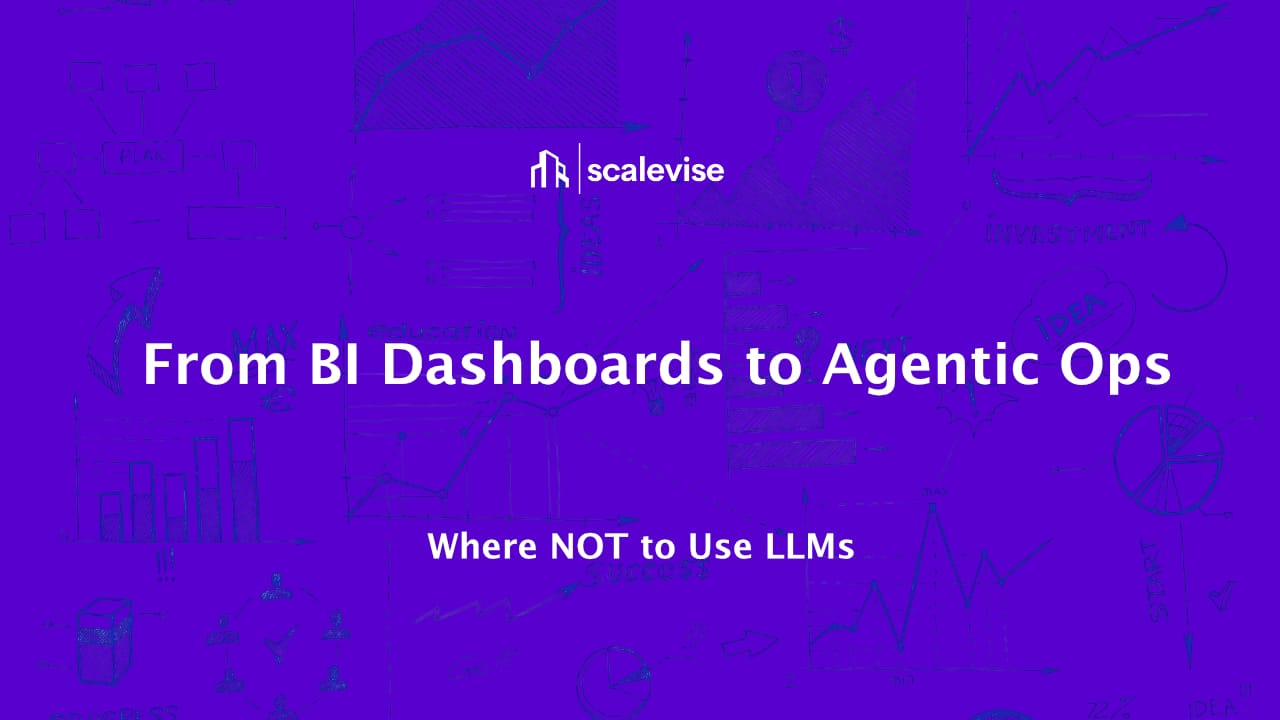From BI Dashboards to Agentic Ops: Where Not to Use LLMs

A practical “don’t use an LLM here” list, a decision test, and safer patterns that save cost and headaches.
TL;DR
LLMs shine in unstructured and exception-handling work with a human in the loop. They are a poor fit for deterministic joins, canonical metrics, and anything that must be identical every time. Start with a decision test, then choose a simpler pattern if the job is deterministic.
The “don’t use LLM here” list
Avoid LLMs when the task is:
- Deterministic ETL: Row-level transforms, schema validation, type coercion
Use: SQL/DBT/ETL with tests - Canonical metrics: Revenue, churn, MRR, regulatory reports
Use: Well-defined models, versioned logic, peer review - Static KPI dashboards: Fixed filters, fixed drill paths
Use: Cached queries or materialized views - Access control decisions: Who can see which records
Use: Rules/policy engine (OPA/Cedar-style), not generative output - Bulk PII handling: Masking/redaction at scale
Use: Deterministic redaction libs and column policies - Anything that must match exactly: Invoices, tax fields, compliance forms
Use: Templates and strict validators
The 5-question decision test
If you answer yes to any of these, try a non-LLM pattern first:
- Will two runs need to produce the exact same result?
- Is there a single correct answer that’s already in a table?
- Would a mistake create legal or customer harm?
- Can you express the logic in rules or SQL?
- Is latency cost-sensitive (pennies per run matter)?
If you answered no across the board and the input is messy (emails, PDFs, notes), an LLM or small agent may help—preferably with review.
A safer architecture for mixed reality
- Deterministic first: Do all joins, filters, and calculations with SQL/ETL
- LLM for unstructured bits: Summaries, classification, entity extraction
- Human-in-the-loop: Confirm anything that creates or changes records
- Policy envelope: Guardrails for inputs (size, file types) and outputs (allowed actions)
- Audit trail: Store prompts, parameters, and diffs for each run
This cuts both risk and cost.
Cost reality: tokens are not your only bill
- Memory/state: Long contexts and “always-on memory” can bloat spend
- Networking/VPC: Cross-AZ and egress fees sneak into agent workflows
- Observability: Logs and traces cost money but prevent bigger costs later
- Retries: Silent retry loops can double your bill—cap them
A hybrid (LLM for messy bits, rules/SQL for the rest) usually wins on TCO.
Patterns that replace LLMs (and work better)
- Regex + dictionary match for part numbers, SKUs, and short codes
- Finite state machines for stepwise forms and approvals
- Policy engine for entitlements and data visibility
- Heuristic rankers (BM25, embeddings search) before calling an LLM
- Template + validator for emails, invoices, shipping labels
These are faster, cheaper, and predictable.
Where LLMs do shine in ops
- Triage: Categorize inbound messages and route to the right queue
- Summarize exceptions: Compress a messy log into a human-readable brief
- Suggest next steps: Propose actions for a person to confirm
- Light extraction: Pull fields from semi-structured text when perfection isn’t required
Pair each with a confirmation step and a rollback.
The “agentic ops” checklist (short, operational)
- Inputs bounded: Max rows/time, allowed file types, size caps
- Actions explicit: List exactly what the agent may do (create task, update status)
- Step cap: Maximum number of tool calls per run
- PII handling: Mask fields by default, log only what’s needed
- Explainability: Every run produces a summary and a diff
- Kill switch: One toggle to stop actions and drop to “suggest only”
| Task type | Use LLM? | Preferred pattern | Review needed |
|---|---|---|---|
| Join/clean/validate rows | No | SQL/ETL with tests | Not needed |
| Static KPI refresh | No | Materialized views / cache | Not needed |
| Classify inbound emails | Maybe | Heuristics → LLM fallback | Yes |
| Extract fields from PDFs | Maybe | Parser → Regex → LLM if needed | Yes |
| Create CRM tasks from notes | Yes | LLM suggestion → human confirm | Yes |
| Draft internal summary | Yes | LLM summarization with source links | Optional |
How to roll this out without friction
- Inventory 10 automations and tag them DETERMINISTIC or MESSY
- Replace LLMs on deterministic flows with SQL/rules
- Add review on messy flows that change data
- Cap steps (tool calls per run) and enable logging
- Publish a one-page policy: what agents can do, what they must not do
What to measure
- Cost per successful action (not per token)
- Error rate on writes and how often people roll back
- Time-to-answer for common requests
- Human touches per 100 runs (aim: trending down with safety intact)
Related reading from Scalevise
- Hidden Cost of SaaS AI Agents & Self-Hosting
- AgentCore (Bedrock) Pricing Explained
- Google’s Data Agents Will Eat Your BI Backlog
Need help choosing where to keep or drop LLMs?
We’ll review your flows and map a keep, replace, add-review plan in one session. Contact Scalevise!
